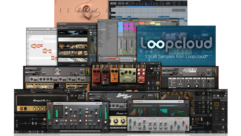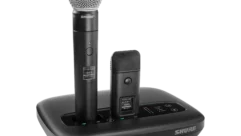
Audio Networks for TV Shows, Part 2
Jun 23, 2010 12:00 PM
Listen to the Podcasts
|
Editor’s note: For your convenience, this transcription of the podcast includes Timestamps. If you are listening to the podcast and reading its accompanying transcription, you can use the Timestamps to jump to any part of the audio podcast by simply dragging the slider on the podcast to the time indicated in the transcription.
Screaming chefs and tumbling 500lb. cakes might seem an odd mix with the audio networking, but the mayhem in the kitchen on TLC’s Ultimate Cake Off is captured by Stickman Sound with RockNet. Fernando Delgado takes us through a day of taping this show.
Fernando, we were talking in part one about how you do sound on The Ultimate Fighter TV show and how you use RockNet for that; you also do sound for TLC’s Ultimate Cake Off.
Fernando Delgado:Yes sir.
Related Links

Audio Networks for TV Shows, Part 1
Viewers of the steel cage matches on The Ultimate Fighter TV show may not be thinking about audio networking, but that’s what brings revved up sound from the crowd, the fighters and the announcers. Fernando Delgado of Stickman Sound in Las Vegas takes us backstage for audio networking to go with RockNet…
They make some huge cakes, weighing around 500lbs., on that show and they’ve got to do it in something like 9 hours, so I guess there aren’t a whole lot of retakes. If there are any, I guess you certainly don’t want it to be because of the audio gear. So what was it like doing the Ultimate Cake Off? What kind of setup do you have to do for that?
Ultimate Cake Off is a very cool setup. What we’re doing on that one is we’re utilizing RockNet to bring in 16 cast member microphones. We’ve got three teams of four and then four judges, so we have 16 wireless mics there as well as a couple of interview stations set up where we have microphones coming in for the interview stations where they ask judges and whatnot questions. So I think it’s a total of 18 inputs, and we bring all of that into RockNet and we distribute it between three consoles. One is the [Yamaha] DM2000 and the other two are [Yamaha] LS9s. [Timestamp: 1:59]
What kind of wireless mics are you using for that?
We are using Lectrosonics on all of our cast members. Basically, the way the signal flow is the wireless receiver into the RockNet 101 boxes, and we output all of those microphones exactly the same to the three consoles. And then there’s three mixers, and each mixer mixes the two cameras as well as a multitrack system. So we take the outputs of our RockNet on the consoles back down the snake and utilize the 16 outputs on the 101 boxes to feed to our cameras and talent IFB. [Timestamp: 2:39]
OK and do you do a lot of traveling on this thing, or is thing set up pretty much in the same place all the time?
The show itself is set up in a studio. The competition itself is done in a studio, and that equipment never moves. We do have a ENG day where we have two ENG mixers that go out into the field and shoot the event that the cakes were designed for. [Timestamp: 3:02]
With that many wireless mic systems going, do you ever have any problems with frequency coordination or interference, things like that?
Not really. I use IAS for my frequency coordination, and I recommend it to anybody that doesn’t use it. I’ve had great luck with it so far, and I’ve been using it probably a little over two years, I think. [Timestamp: 3:20]
How long do you have to set up for Ultimate Cake Off when you first get in there?
Our install’s about three days, four days. [Timestamp: 3:26]
OK, and before the production starts you’ve got to have people to get ready and miked up and checked out and make sure that nobody’s having any problems. That many people with wireless gear, have you got an A2 for that? You don’t have to deal with all that yourself?
On that show, we have a four-man crew. There’s myself and two other A1 mixers that mix in the control room with me and then an A2 that lives on the studio floor. He wires everybody up, he deals with batteries. He wires everybody and just basically maintains the floor during the competition. [Timestamp: 3:59]
Now this is done in a studio. Do you have to run Cat-5 for every show or does all that stuff stay in place?
Well, we shoot 12 episodes in a season, so it’s six weeks. We’ll go in four or five days before shooting, do our install, which only takes a few days, and then we’re up and running. So once we start shooting, they’re essentially three-day episodes, so the competition is on one day then the event that the competition is designed for is another day of shooting. And then we also have another day for interviews and any pickups or anything that they may need from our hosts. [Timestamp: 4:32]
Audio Networks for TV Shows, Part 2
Jun 23, 2010 12:00 PM
Have they ever had what I guess you would call a cake disaster? I’ve seen some things on there where the cakes fall over and so forth, but I guess that doesn’t affect you guys that much.
Nope, that’s all part of the competition. [Timestamp: 4:44]
Well, as long as you can hear everybody and you don’t have problems with that, but as many people as there are running around and hollering. These people can really get into this stuff. It can get a little on the emotional side after they spent hours on one of these cakes.
It can get a little crazy, I suppose, but a good A2 is the key to just about any show you do, and I’m happy to say that the guys that I surround myself with are top-notch. The A2 on that show is awesome. And so he runs the floor and he only calls us when he really needs us, and we don’t hear from him all that often, so it’s great. [Timestamp: 5:19]
What do you do for intercom on that show? How do you communicate with everybody and string all that up?
The previous seasons, the last two seasons, the production company rented a wireless PL system from a rental company. Both seasons didn’t really work out that well. If the show comes back for a third season I am looking into an Artist System from Riedel. That will help their scenario, it will help my scenario, and right now I can’t go wrong with anything that Riedel is putting out. It’s all really, really good stuff. [Timestamp: 5:47]
And you’re recording multitrack, so you’ve got everybody sorted out. What’s the postproduction like on that show?
It’s actually not too difficult. We’re recording to cameras, and basically the way it works is one camera shoots a kitchen, so there is one camera dedicated to the host and then one camera dedicated to each team. So we mix those teams directly to camera so when they go to post, they have everything right there on the tape that they’re importing for video. Should they need to go to the multitrack, we’re slaved off of their master timecode, and everything that we deliver to them is on a hard drive. We roll everything broadcast wave, so it’s all timecode-embedded and they just import what they need. We’ve been working with this postproduction team for a really long time also at this point so the workflow is just snap-snap; easy. [Timestamp: 6:38]
All right, so you’re not only doing a multitrack but you’re also doing a live mix that they can use and post if things go OK, which I am sure speeds things up dramatically.
Yeah, that’s the idea. We want to try to give them as close to a perfect mix as possible. And it’s never perfect doing a 10-hour competition; it’s hard. But that being said, we do, we try to give them as good of a mix as we possibly can during the competition so that they only have to go to the multitrack when they need it. [Timestamp: 7:07]
Yeah, I would think that’s a challenge because you’ve got people who are yelling and hollering and compression is needed and the possibility of overmodulating the transmitters. Do you ever have any problems with that?
We really haven’t had too much trouble with overmodulation. I think the biggest challenge, for that show in particular, is all of the kitchens are within one room, so our ambient noise levels vary from—just every 2ft. or 3ft., it’s such a dramatic difference in ambient levels to be able to mix a show and have it be relatively consistent across the board. Also with three different sets of ears mixing the show, it is quite a challenge. I think the postproduction does a really good job of balancing everything out. [Timestamp: 7:52]
Have you ever had any really unusual things happen with that show yet that were not on the menu?
Not yet.
Well, keep your fingers crossed.
And that’s the beautiful thing about, or at least the appeal to me, about doing reality TV is the variables are always changing so the fun part is keeping up. [Timestamp: 8:09]
Yeah, you never know what you’re going to run into. They’re all doing this stuff for real, so I guess the thing you guys have to do is just make sure you’re set up right and then just fade into the background and stay out of everybody’s way.
That’s about it, and be able to adapt to any changes that they throw at you. [Timestamp: 8:24]
All right, well this has been something getting behind the scenes with RockNet on the Ultimate Cake Off and The Ultimate Fighter. Thanks for sharing that with us. Fernando Delgado of Stickman Sound in Las Vegas, thanks for being here.
Thank you, I appreciate it.










